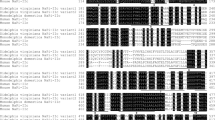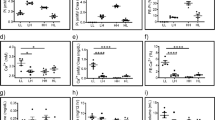Abstract
X-linked hypophosphatemic vitamin D-resistant rickets is the most common inherited form of vitamin D-resistant rickets in man. The current studies were designed to characterize the defect in the sodium (Na+)-phosphate transporter in the (Hyp) mouse model. The slope of initial rate of phosphate uptake was significantly decreased in the kidney but not in intestinal brush border membranes of the (Hyp) mice compared with genetically matched controls. Phosphate uptake by the basolateral membranes of the intestine and kidney was similar in the (Hyp) and control mice. Kinetic analysis of phosphate uptake by renal brush border membranes showed aV max of 0.32±0.06 and 1.6±0.1 nmol/mg protein per 15 s (P<0.01) andK m of 0.07±0.06 and 0.39±0.05 mM in (Hyp) and control mice respectively (P<0.05).V max andK max of jejunal uptake of phosphate were similar in (Hyp) and control mice. To confirm these findings, we expressed the Na+-phosphate transporter inXenopus laevis oocytes. Na+-dependent phosphate uptake in the oocytes was expressed 6 days after renal and intestinal poly(A)+ RNA injection, however, uptake values were significantly lower in oocytes injected with renal poly(A)+ RNA from the (Hyp) mice compared with controls (P<0.01). No differences were noted in phosphate uptake by oocytes injected with poly(A)+ RNA from the jejunum of the (Hyp) or control mice. These studies suggest that the defect in the (Hyp) mice is localized to the kidney and is secondary to diminished activity and/or function of the Na+-phosphate transporter.
Similar content being viewed by others
References
Eicher EM, Southard JL, Scriver ER, Glorieux FH (1976) Hypophosphatemia: mouse model for human familial hypophosphatemic rickets. Proc Natl Acad Sci USA 73:4667–4671
Cowgill LD, Goldfarb S, Lau K, Slatopolsky E, Agus ZS (1979) Evidence for an intrinsic renal tubular defect in mice with genetic hypophosphatemia. J Clin Invest 63: 1203–1210
Tenenhouse HS, Scriver CR (1979) Renal brush border membrane adaptation to phosphorus deprivation in theHyp/Y mouse. Nature 281: 225–227
Glorieux FH, Morin CL, Traverers R, Delvin EE, Poirer R (1976) Intestinal phosphate transport in familial hypophosphatemic rickets. Pediatr Res 10: 691–696
Chan JCM, Lovinger RD, Mamunes P (1980) Renal hypophosphatemic rickets: growth acceleration after long-term treatment with 1,25-dihydroxyvitamin D3. Pediatrics 66: 445–454
Tenenhouse HS, Fast DK, Scriver CR, Koltay M (1981) Intestinal transport of phosphate anion is not impaired in theHyp (hypophosphatemic) mouse. Biochem Biophys Res Commun 100: 537–543
Nesbitt T, Coffman TM, Griffiths R, Drezner MK (1992) Crosstransplantation of kidneys in normal andHyp mice: evidence that theHyp mouse phenotype is unrelated to an intrinsic renal defect. J Clin Invest 89: 1453–1459
Meyer RA, Meyer MH, Gray RW (1989) Parabiosis suggests a humoral factor is involved in X-linked hypophosphatemia in mice. J Bone Miner Res 4: 493–500
Barnard JA, Ghishan FK, Wilson FA (1985) Ontogenesis of taurocholate transport by rat ileal brush border membrane vesicles. J Clin Invest 75: 869–873
Kikuchi K, Ghishan FK (1987) Phosphate transport by basolateral plasma membranes of human small intestine. Gastroenterology 93: 106–113
Scharschmidt BF, Keeffe EB, Blankenship NM, Ockner RK (1979) Validation of a recording spectrophotometric method for measurement of membrane-associated Mg++ and Na+−K+-ATPase activity. J Lab Clin Med 93: 790–799
Beaufay HA, Amas-Costesec AA, Feytmans E, Thines-Sempoux D, Wibo M, Robbi M, Berthet J (1974) Analytical study of microsomes and isolated subcellular membranes from rat liver. J Cell Biol 61: 188–200
Lowry OH, Rosebrough NJ, Farr AL, Randall RJ (1951) Protein measurement with the Folin phenol reagent. J Biol Chem 193: 265–275
Ghishan FK, Wilson FA (1985) Developmental maturation ofd-glucose transport by rat jejunal brush border membrane vesicles. Am J Physiol 248: G87-G92
Chirgwin JM, Przbyla AE, MacDonald RJ, Rutter WJ (1979) Isolation of biologically active ribonucleic acid from sources enriched in ribonucleases. Biochemistry 18: 5294
Nakagawa N, Arab N, Ghishan FK (1991) Characterization of the defect in the Na+-phosphate transporter in vitaminD-resistant hypophosphatemic mice. J Biol Chem 266: 13616–13620
Author information
Authors and Affiliations
Rights and permissions
About this article
Cite this article
Nakagawa, N., Ghishan, F.K. Sodium-phosphate transport in the kidney and intestine of the hypophosphatemic mouse. Pediatr Nephrol 7, 815–818 (1993). https://doi.org/10.1007/BF01213366
Received:
Revised:
Accepted:
Issue Date:
DOI: https://doi.org/10.1007/BF01213366




